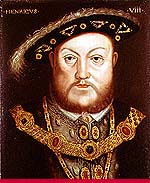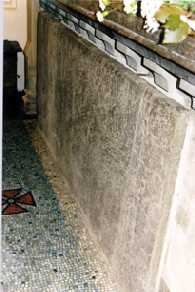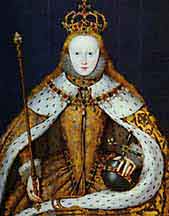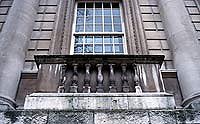History of Leatherhead
Parish Church, St.Mary & St.Nicholas
1500-1749
This website is maintained
by the Friends of Leatherhead Parish
Church
Unless stated the images shown are from sources other than
Leatherhead Parish Church
In 1541 during the reign of Henry VIII, as part of the Dissolution of the Monasteries, Leeds Priory was 'suppressed'. Leeds Priory's property was given to the Dean and Chapter of Rochester Cathedral. They still retain the right to
nominate the incumbent of St Mary & St Nicholas,
Leatherhead. Nowadays the incumbent is a Vicar. |
  Arms of the Diocese of Rochester |
|
1548 The Reformation. An Order in Council directs the removal of all images especially the Great Rood, with its attendant figures of St.Mary and St.John. Mural paintings were lime washed and obliterated, and substituted with sentences of Holy Writ. |
||
1549 First Inventory of Church Goods |
|
|
1550 An order is received from all Bishops that old stone altars are to be destroyed and replaced by plain wooden Communion tables. Leatherhead ignores this - the mediaeval mensa
or top slab of the altar now lies preserved behind
the present High Altar. Made of Sussex marble, it has
the usual five consecration crosses symbolizing the
five wounds of Christ. |
 the mediaeval mensa behind the present High Altar |
|
1571 Robert Gardiner, of Thorncroft Manor Serjeant of the Royal Wine Cellar to Elizabeth I 'departed this transitory world the tenth day of November A.D. 1571, being then of the age of 73 years.'. His funerary helmet and his epitaph written by Thomas Churchyard, Court Poet to Elizabeth I, are displayed in the church. Gardiner's gravestone is set in the floor of the Chancel. Another eminent Courtier who owned property in Leatherhead was Edmund Tylney, Master of the Revels to the Queen and later to James I of England. His house was on the site of the The Mansion in Church Street, presently the Register Office. Queen Elizabeth I dined with him there on 3rd August 1591 during one of her progresses. |
 Elizabeth I
Epitaph to
Robert Gardiner by Thomas Churchyard |
|
Civil War and the Interregnum No Feast Days allowed and between 1653 and 1660. Even marriage services in church were forbidden. |
||
Restoration of the Monarchy Another Serjeant of the Royal Wine Cellars is buried in the Chancel - Richard Dalton, a friend of Samuel Pepys. Also buried there is Lowde Cordell, died 1685, a Page of the Royal Bedchamber to Charles II. |
 Charles II |
|
Richard Hanbury, Vicar of Leatherhead 1679-1689, is made Chaplain to James II. Presumably this was a sensitive task, as the Catholic James was deposed in the 'Glorious Revolution' of 1688 by the Protestant William of Orange. |
 James II |
|
1701-20 Some 'modernisation', probably reflecting the religious prejudices of the time in favour of fundamentalism. Elliptical
arch inserted within Chancel arch. |
||
1703 original spire blown down in the storms of late November, never to be rebuilt, like many other churches in the South. The Eddystone Lighthouse was lost in the same storms. |
||
1715 Following an endowment to the Vicars of Leatherhead, Great Bookham, Effingham and Shalford from Dr Shortridge, the Rector of Fetcham, there began the annual King Charles Sermon on January 30th, the anniversary of his execution in 1649. The preaching of this sermon continues to this day. A Tablet on the South Wall lays down all the conditions of this bequest, including a requirement that Holy Communion should be celebrated at least once a month. |
  Banqueting House, Whitehall, London BBCwebsite for more information |
|
1746 Gallery built across the front of the tower. |